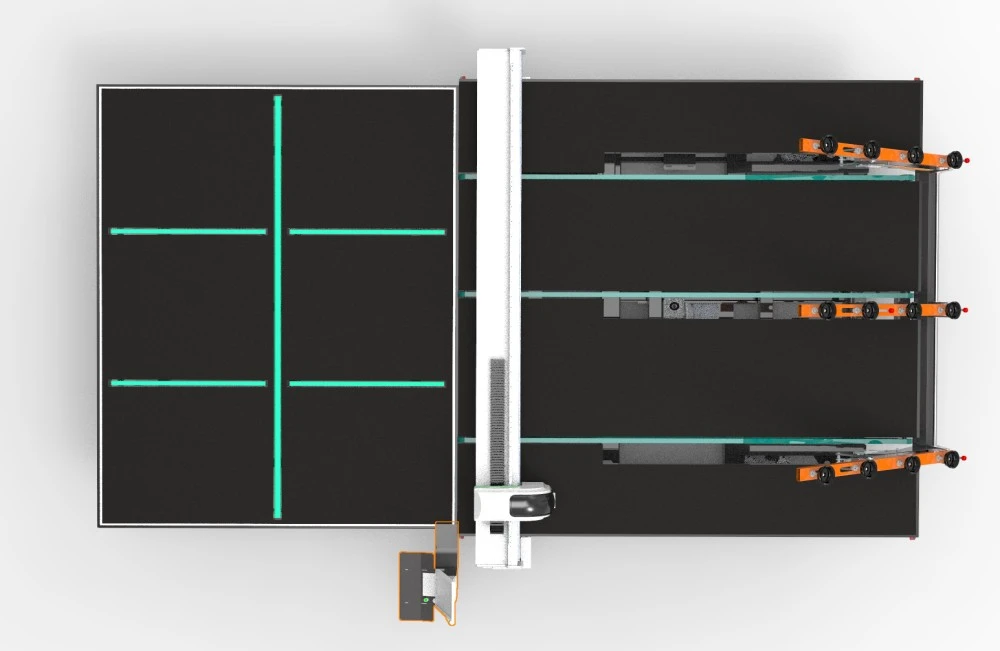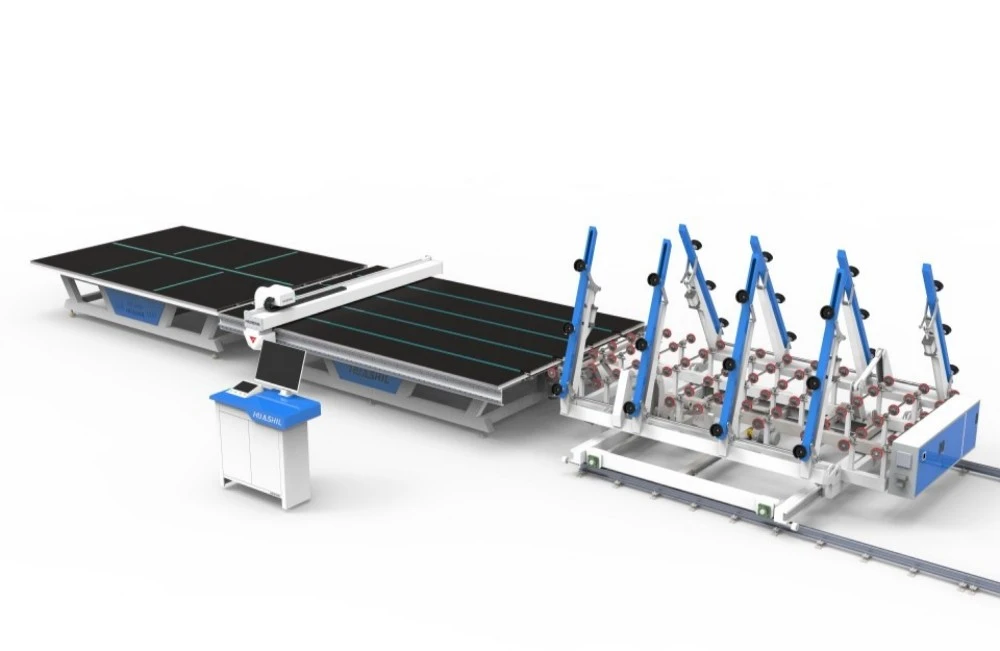When it comes to cutting glass with precision and efficiency, manufacturers often find themselves at a crossroads: should they opt for a waterjet cutting machine for glass or one that utilizes a diamond blade? Both technologies have their merits and drawbacks, making the choice a crucial decision for businesses in the glass industry. In this comprehensive guide, we'll explore the differences between waterjet and diamond blade cutting machines, helping you make an informed decision for your glass cutting needs.
Comparing cut quality: waterjet vs. diamond blade
The quality of the cut is paramount in glass manufacturing, and both waterjet and diamond blade technologies offer unique advantages in this regard.
Waterjet cutting machines use a high-pressure stream of water mixed with abrasive particles to cut through glass. This method produces a clean, smooth edge with minimal chipping or cracking. The absence of heat in the cutting process means there's no risk of thermal stress or distortion in the glass.
On the other hand, diamond blade cutting machines rely on a rotating blade embedded with industrial-grade diamonds to score and break the glass along a predetermined line. While this method can produce very precise cuts, it may result in slightly more chipping along the cut edge compared to waterjet cutting.
One significant advantage of waterjet cutting is its ability to create intricate shapes and patterns with ease. The versatility of the water stream allows for complex designs that might be challenging or impossible with a diamond blade. However, diamond blade cutting tends to be faster for straight cuts and is often preferred for large-scale production of simple shapes.
In terms of thickness, waterjet cutting machines can handle a wide range of glass thicknesses, from thin sheets to thick blocks. Diamond blade cutters, while effective for most common glass thicknesses, may struggle with extremely thick or layered glass.
It's worth noting that the quality of the cut also depends on the skill of the operator and the maintenance of the machine. A well-maintained diamond blade cutter in the hands of an experienced operator can produce cuts nearly as smooth as those made by a waterjet cutting machine for glass.

Environmental impact: water usage and waste management
In today's eco-conscious world, the environmental impact of manufacturing processes is a significant consideration. Both waterjet and diamond blade cutting technologies have environmental implications that need to be carefully weighed.
Waterjet cutting machines, as the name suggests, use a substantial amount of water. A typical waterjet cutter can consume anywhere from 0.5 to 4 gallons of water per minute, depending on the pressure and nozzle size. This high water usage can be a concern in regions where water scarcity is an issue. However, many modern waterjet systems incorporate water recycling mechanisms, significantly reducing their overall water consumption.
The abrasive particles used in waterjet cutting machine for glass, typically garnet sand, also need to be considered. Once used, this abrasive slurry becomes waste that requires proper disposal. On the positive side, some facilities have found ways to recycle this waste material for other industrial applications, reducing its environmental impact.
Diamond blade cutting, in contrast, doesn't use water in the cutting process itself. However, water is often used as a coolant to prevent overheating of the blade and the glass. The amount of water used is generally much less than in waterjet cutting.
The primary environmental concern with diamond blade cutting is the production of glass dust. This fine particulate matter can be harmful if inhaled and requires effective dust collection systems to maintain a safe working environment. The collected glass dust can often be recycled, particularly in larger operations.
From an energy perspective, waterjet cutting machine for glass typically consume more power due to the high-pressure pumps required to generate the water stream. Diamond blade cutters, while still energy-intensive, generally have lower power requirements.
Both technologies produce some level of noise pollution, which needs to be managed in the workplace. Waterjet cutters tend to be louder due to the high-pressure water stream, while diamond blade cutters produce a more consistent, lower-frequency noise.
Suitable applications for each cutting technology
The choice between waterjet and diamond blade cutting often comes down to the specific applications and requirements of your glass cutting projects.
Waterjet cutting excels in situations that require:
- Complex shapes and intricate designs
- Cutting of very thick glass
- Minimal heat-affected zones
- Cutting of laminated or coated glass
- Prototyping or small batch production
Diamond blade cutting is often preferred for:
- High-volume production of straight cuts
- Cutting of standard thickness glass sheets
- Applications where speed is a priority
- Situations where water usage needs to be minimized
- Cutting tempered glass (which can shatter if cut with a waterjet)
In the architectural glass industry, both cutting machine for glass technologies find their place. Waterjet cutting might be used for creating unique decorative elements or custom-shaped panels, while diamond blade cutting could be employed for mass-producing standard window panes.
For the automotive industry, diamond blade cutting is often the go-to choice for windshield and window production due to its speed and consistency. However, waterjet cutting might be used for prototyping new designs or creating complex shapes for concept vehicles.
In the realm of cutting machine for glass equipment for smart mirrors and touchscreens, waterjet cutting's ability to handle coated and laminated glass without damaging sensitive layers makes it a popular choice. The precision of waterjet cutting is also beneficial for creating the intricate cutouts often required in these high-tech applications.
For furniture and interior design applications, the choice often depends on the specific project. Waterjet cutting machine for glass might be preferred for one-off, custom pieces with unique shapes, while diamond blade cutting machines for glass could be more efficient for producing multiple identical pieces.
It's worth noting that many glass fabrication facilities opt to have both technologies available. This allows them to choose the most appropriate method for each job, maximizing efficiency and quality across a diverse range of projects.
When selecting a glass cutting table machine, consider factors such as:
- The typical thickness and type of glass you'll be working with
- The complexity of the cuts you need to make
- Your production volume and required throughput
- Your facility's water availability and waste management capabilities
- The initial investment and ongoing operational costs of each technology

The small cutting machine for glass market offers options for both waterjet and diamond blade technologies, catering to businesses with space constraints or lower production volumes. These compact machines can be an excellent entry point for smaller operations or specialized workshops.
For large-scale operations, a float glass cutting machine using either waterjet or diamond blade technology can significantly boost productivity. These machines are designed to handle the large sheets of glass produced by the float glass process, ensuring consistent quality across high-volume production runs.
Ultimately, the decision between a waterjet and diamond blade cutting machine for glass depends on a careful analysis of your specific needs, production environment, and long-term business goals. Both technologies have their strengths, and the right choice will depend on finding the best fit for your unique circumstances.
Conclusion
In the world of cutting machine for glass, both waterjet and diamond blade technologies have carved out their niches. Each offers distinct advantages and is suited to different applications within the glass industry. By understanding the strengths and limitations of each method, you can make an informed decision that aligns with your production needs, quality standards, and environmental considerations.
If you're in the market for a cutting-edge cutting machine for glass solution, look no further than Shandong Huashil Automation Technology Co., LTD. With years of experience in automated R&D, manufacturing, and sales of mechanical equipment, we offer advanced cutting machines for glass that cater to a wide range of industries. Our commitment to quality, precision, and customer satisfaction has made us a trusted partner for businesses worldwide.
Ready to elevate your glass cutting capabilities? Contact our team of experts today at salescathy@sdhuashil.com to discuss your specific needs and find the perfect glass cutting solution for your business. Let's shape the future of glass together!
References
1. Johnson, M. (2022). Advancements in Glass Cutting Technologies: A Comparative Study of Waterjet and Diamond Blade Methods. Journal of Industrial Manufacturing, 45(3), 287-301.
2. Smith, A. & Brown, R. (2021). Environmental Implications of Glass Cutting Processes in Modern Manufacturing. Sustainable Production and Consumption, 18, 123-135.
3. Lee, S., et al. (2023). Optimization of Cutting Parameters for Waterjet and Diamond Blade Glass Cutting Machines. International Journal of Precision Engineering and Manufacturing, 24(2), 456-470.
4. Garcia, F. & Williams, T. (2022). Economic Analysis of Waterjet vs. Diamond Blade Cutting Technologies in the Glass Industry. Journal of Manufacturing Systems, 62, 79-92.



